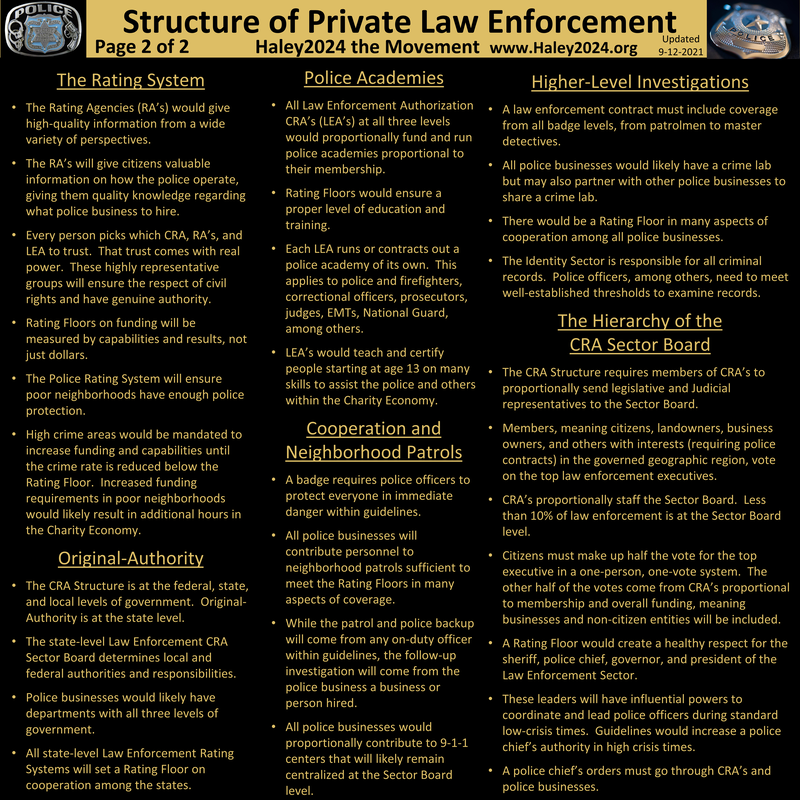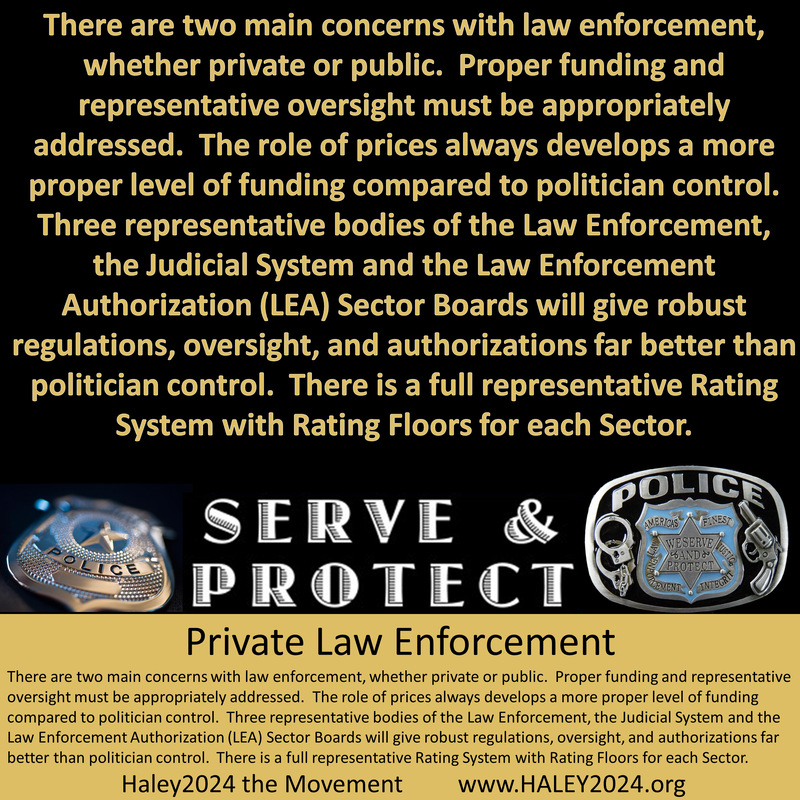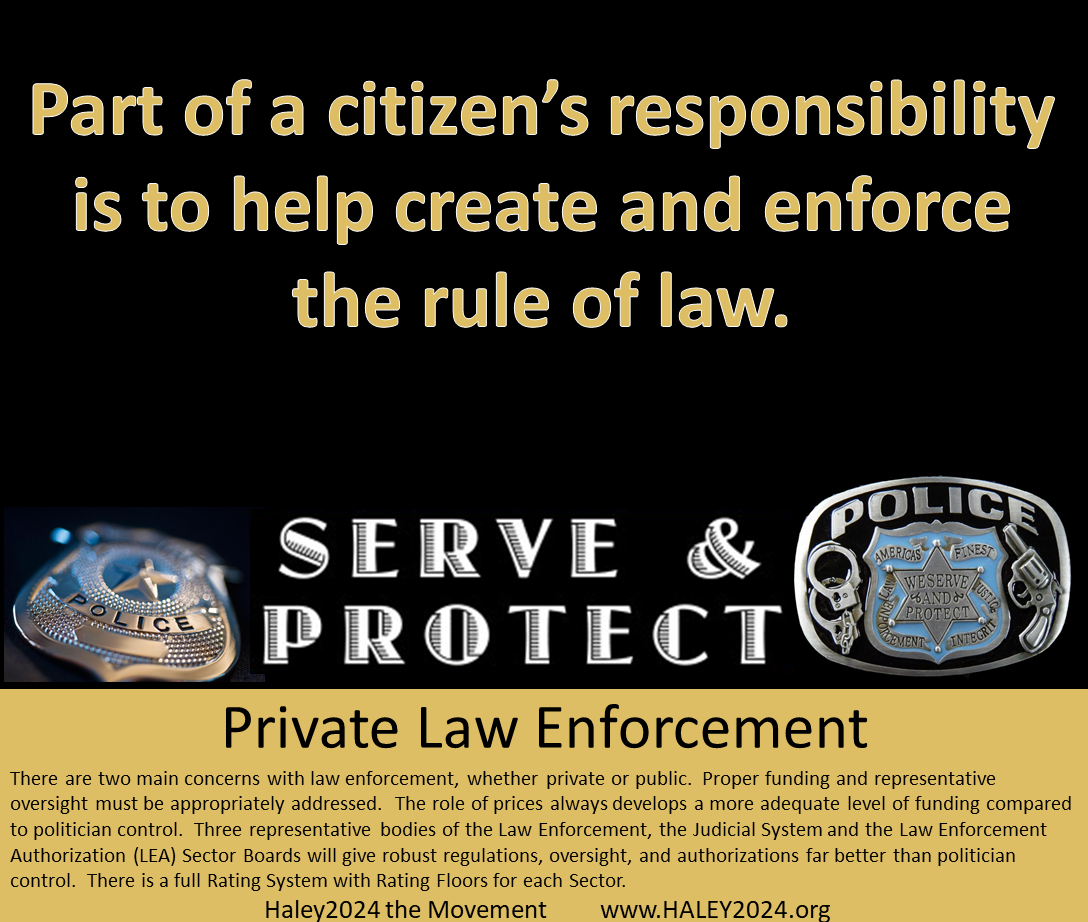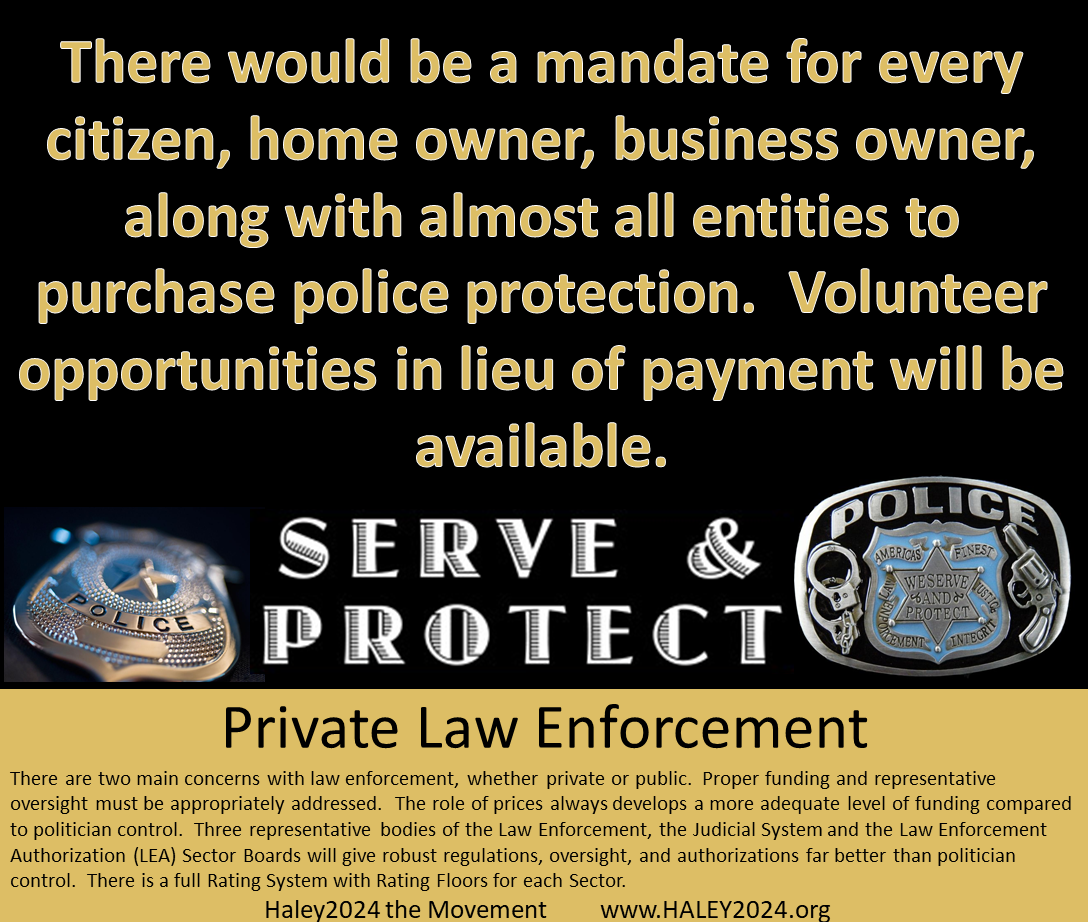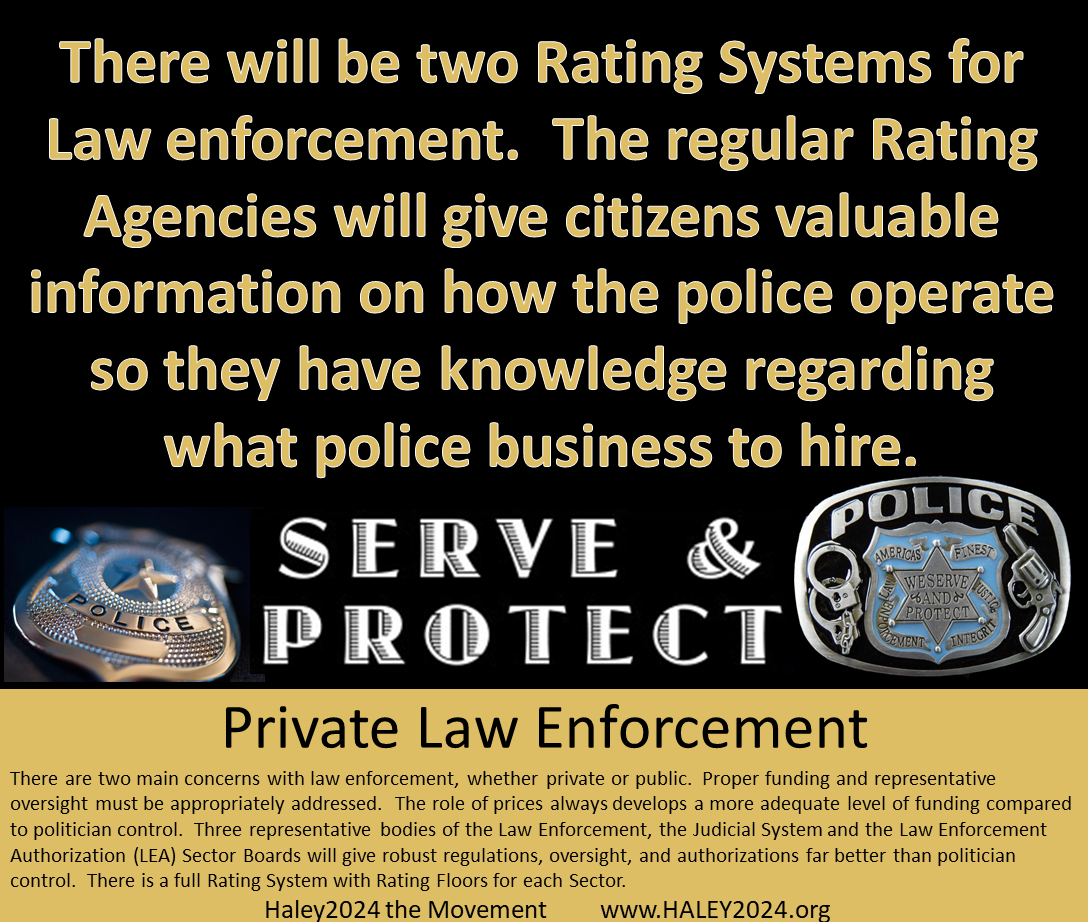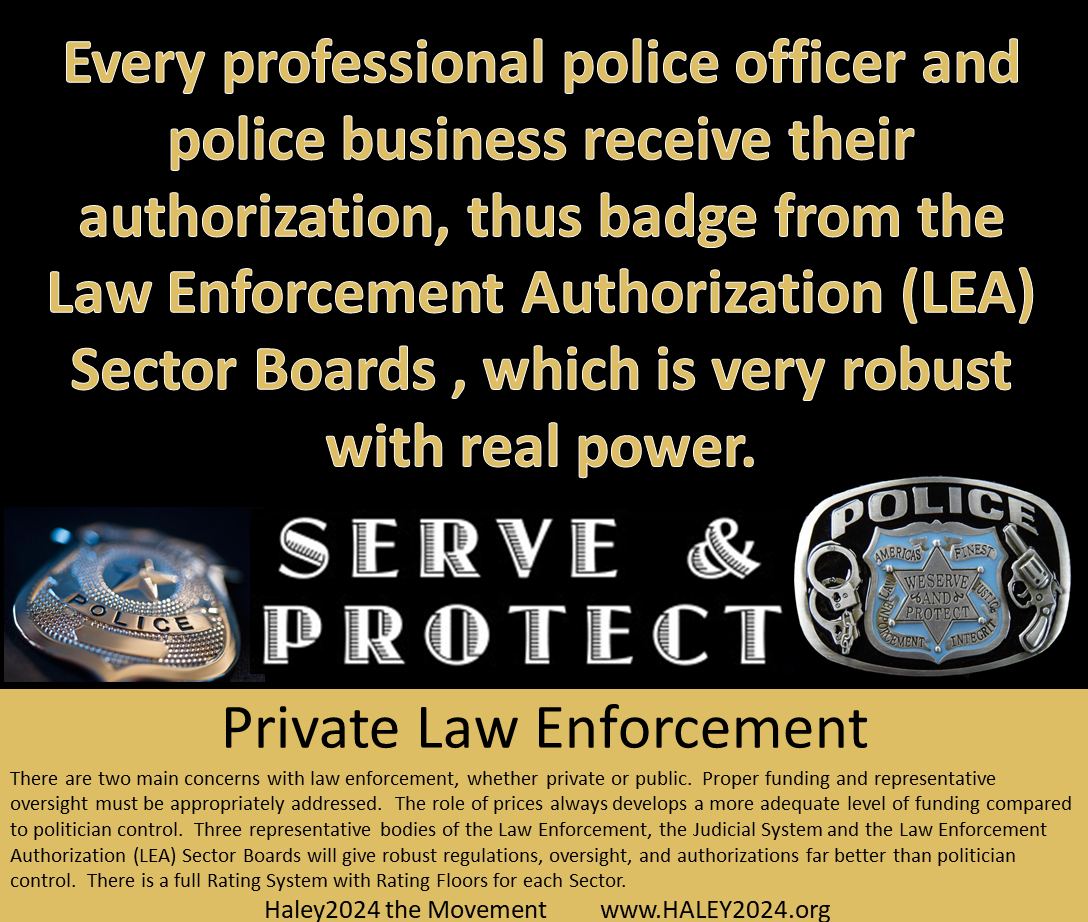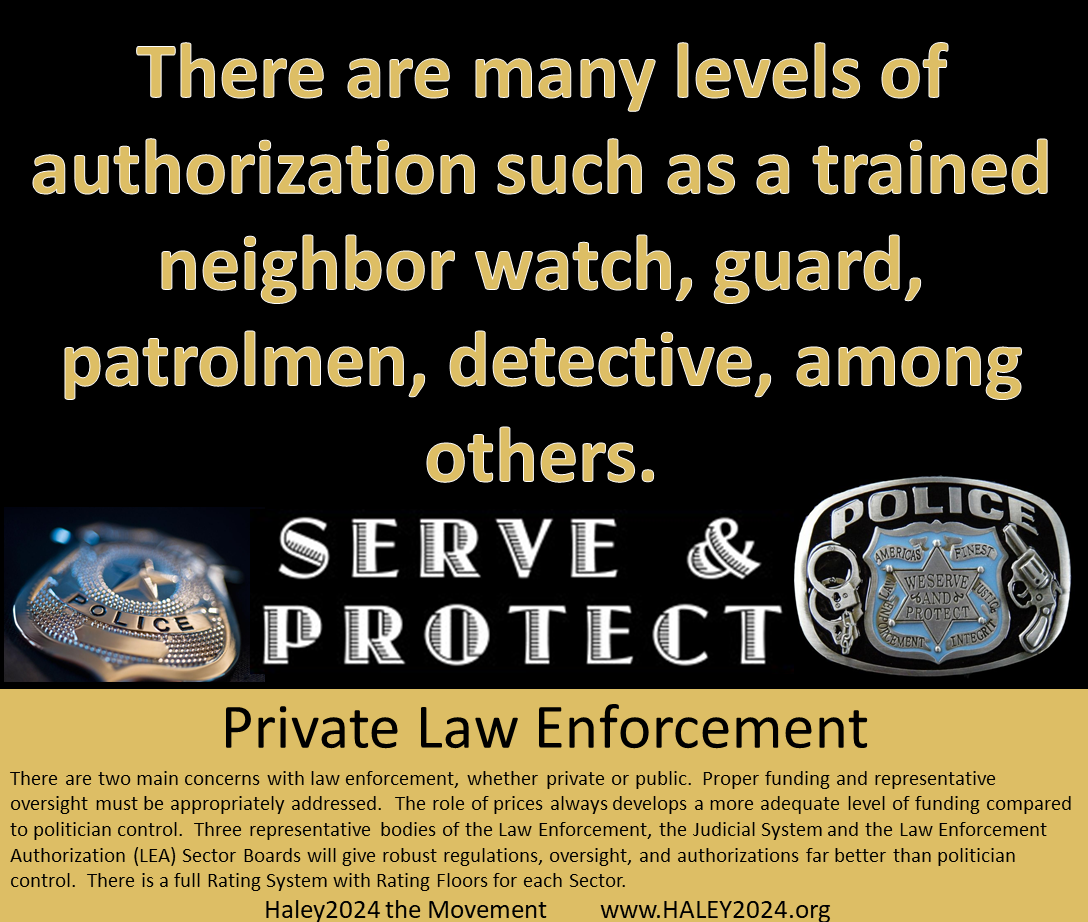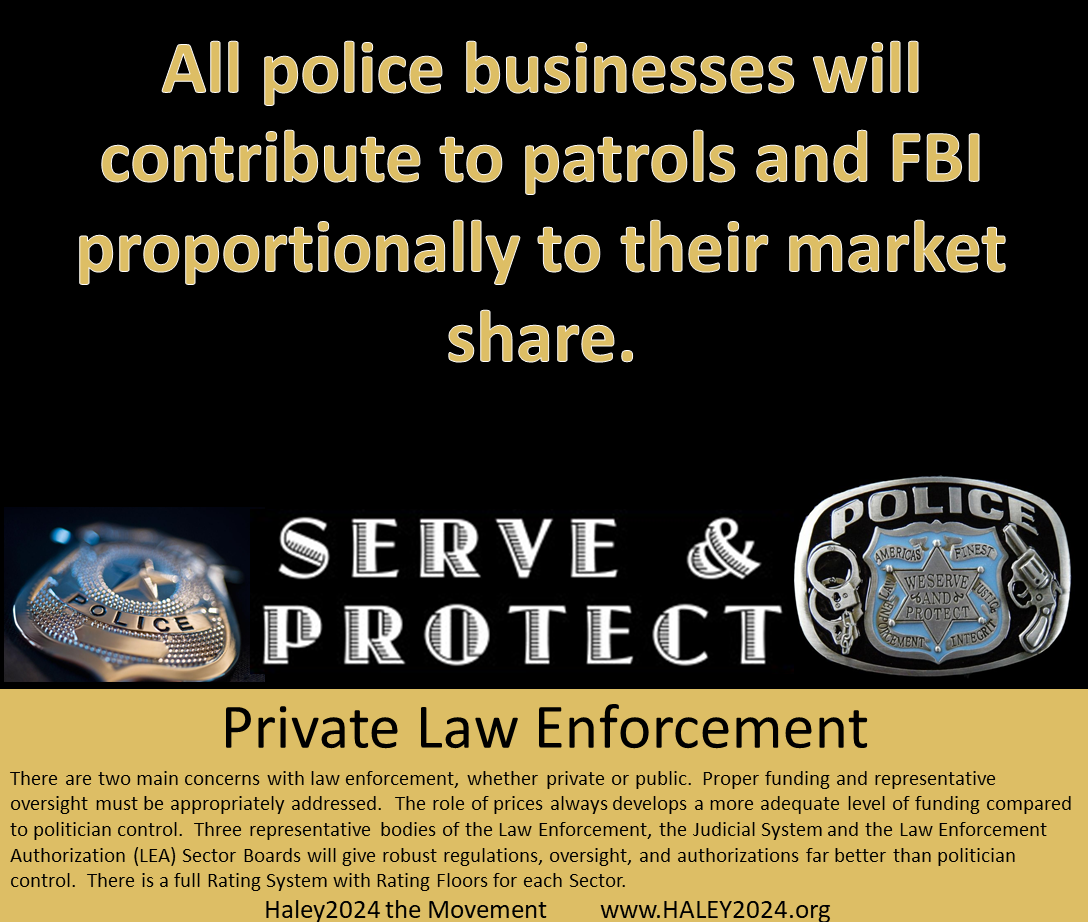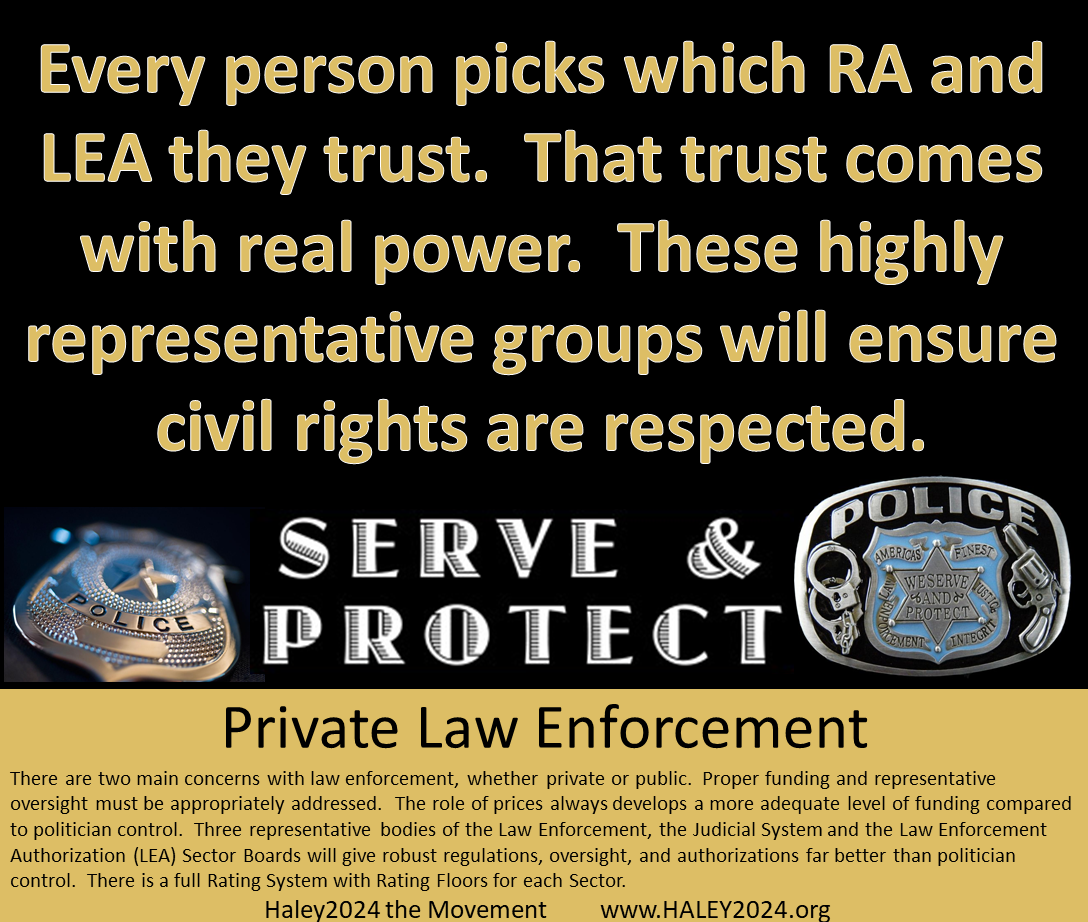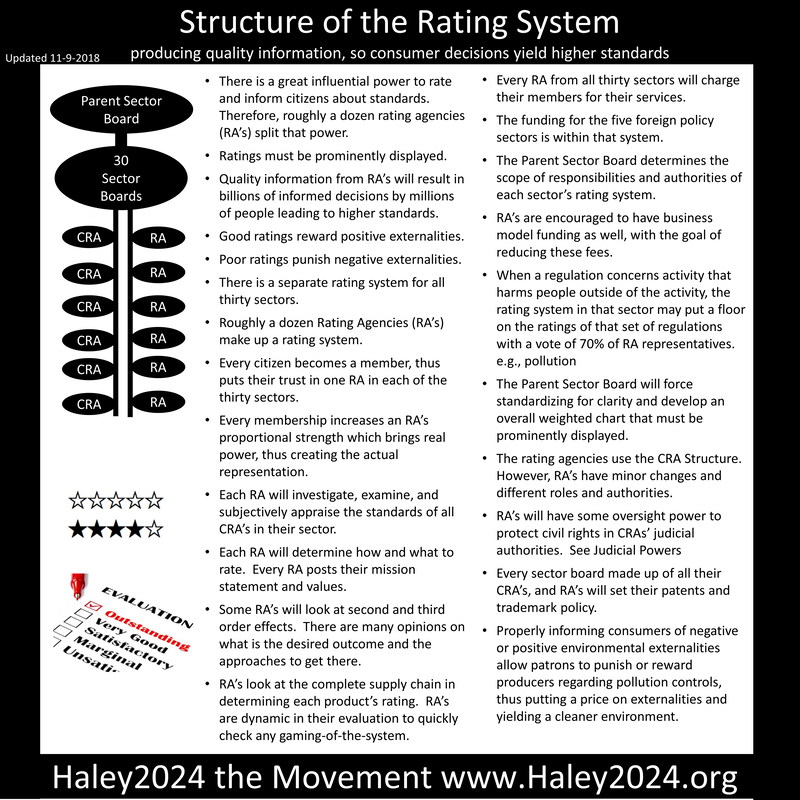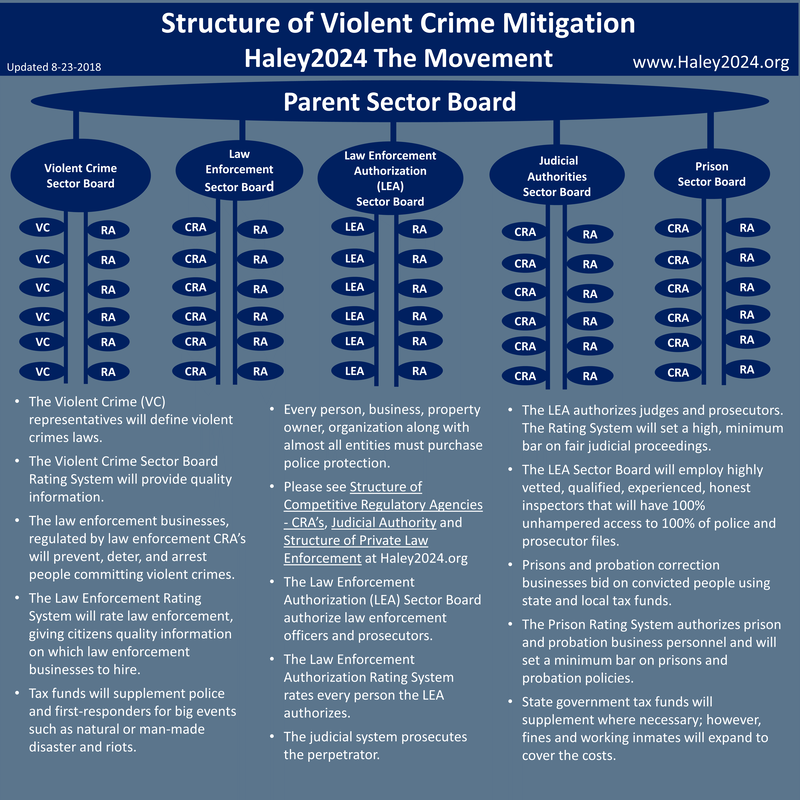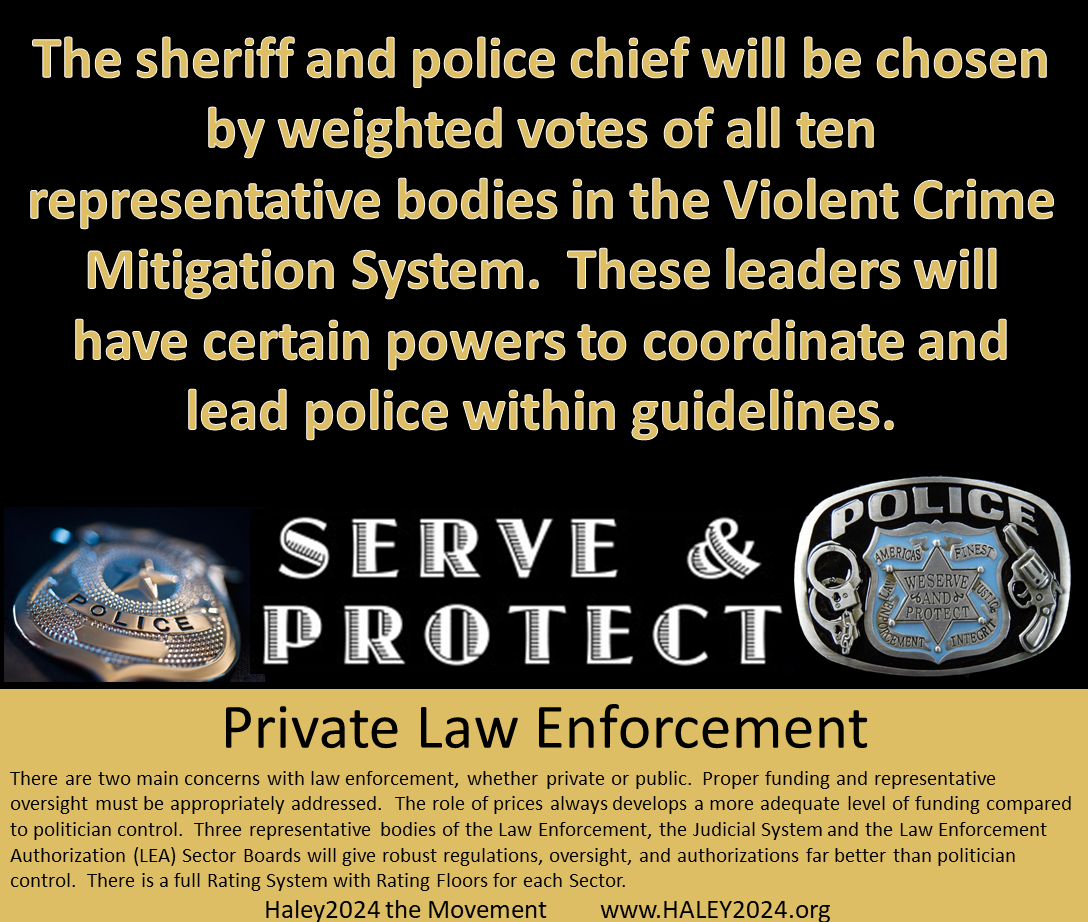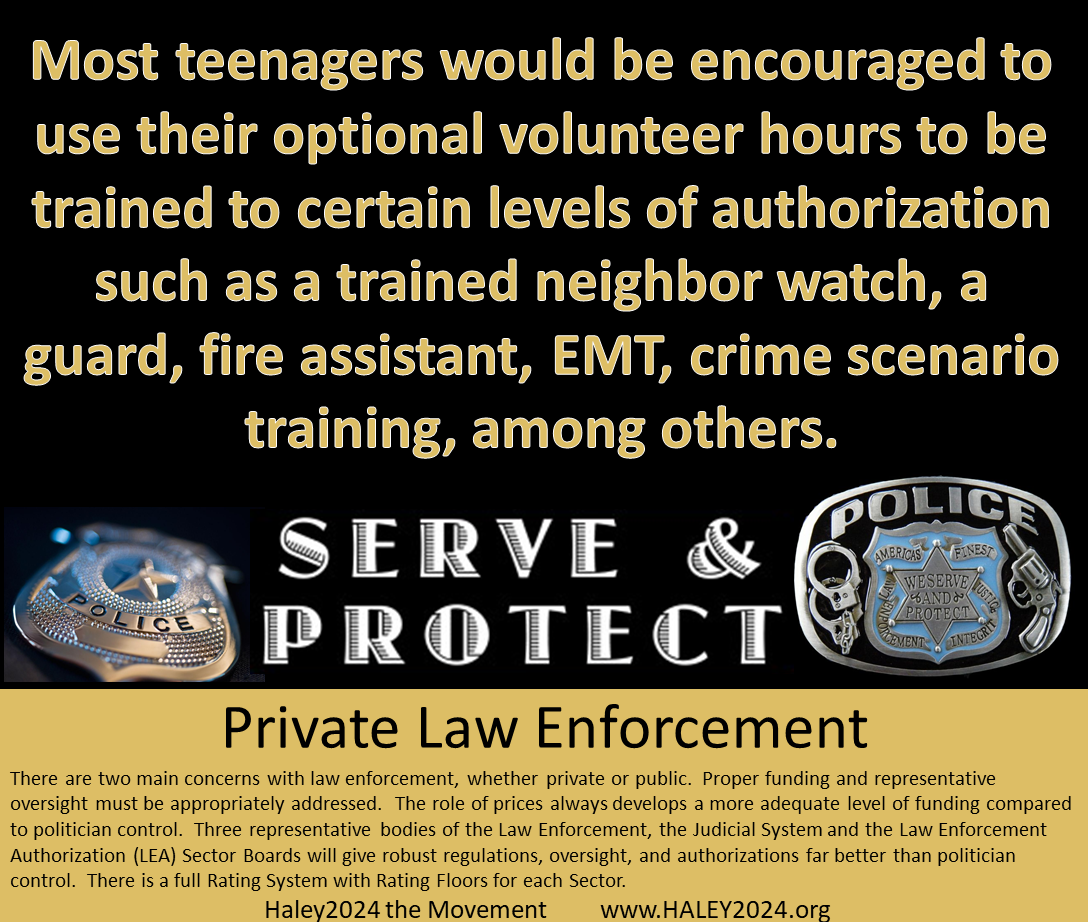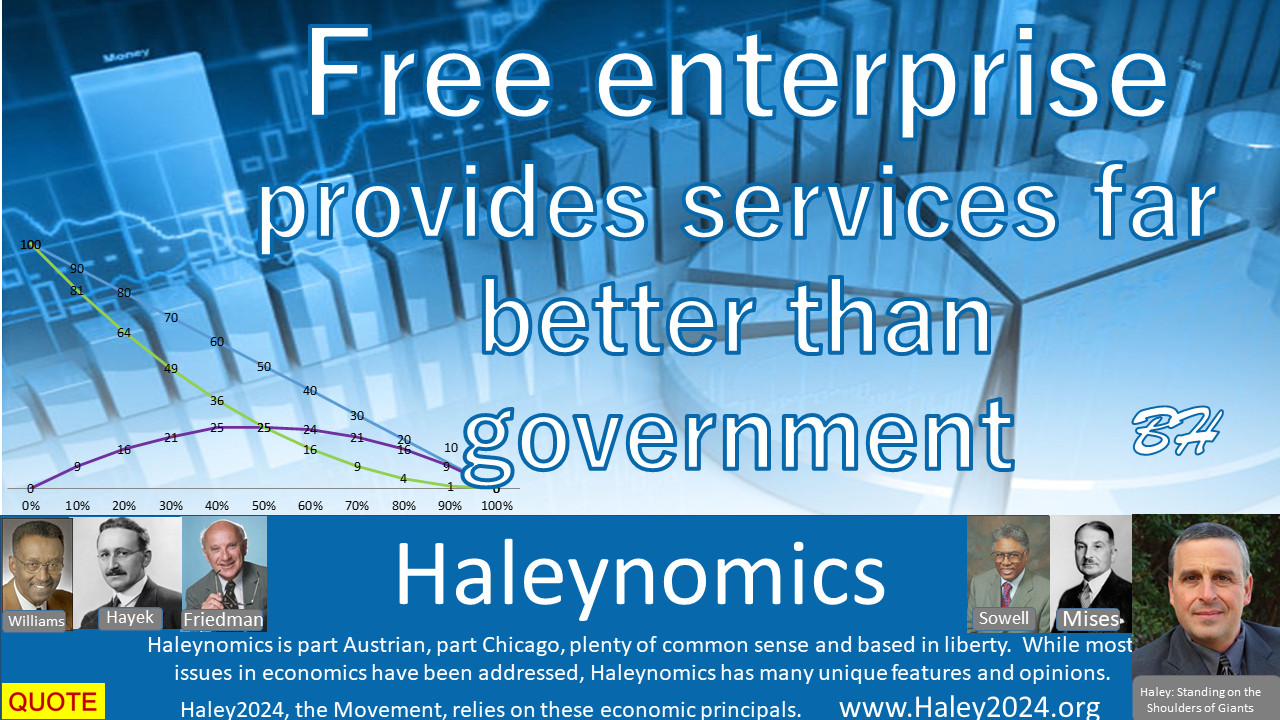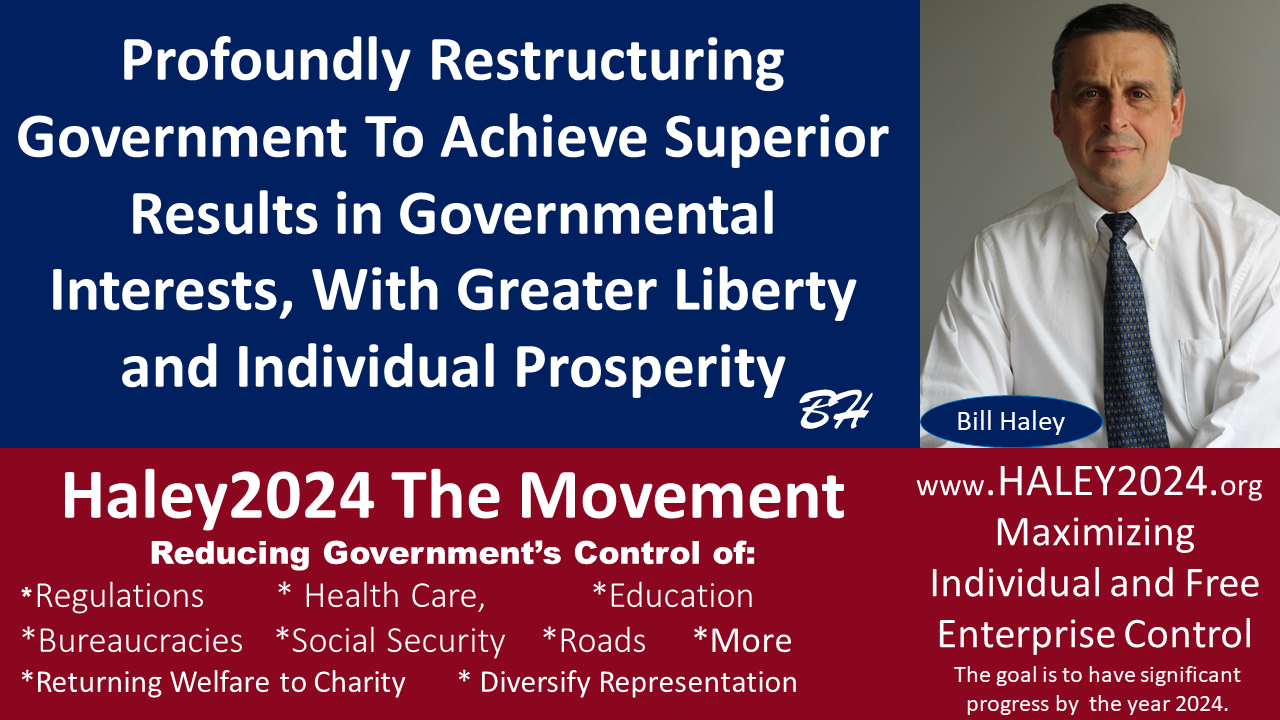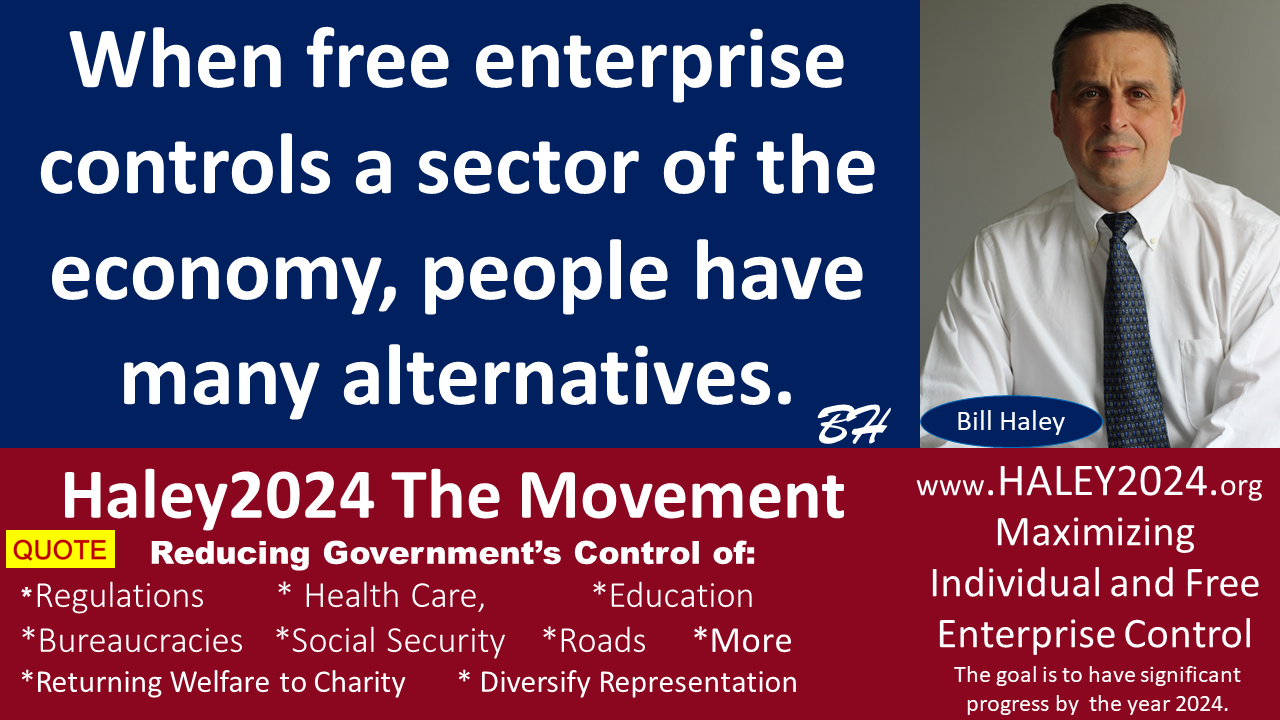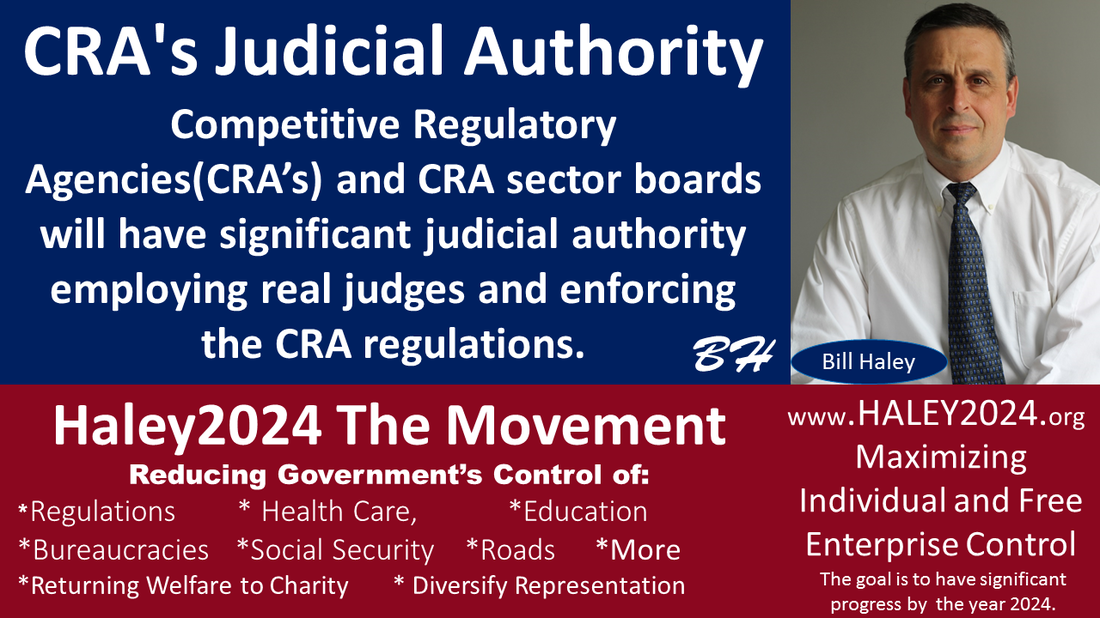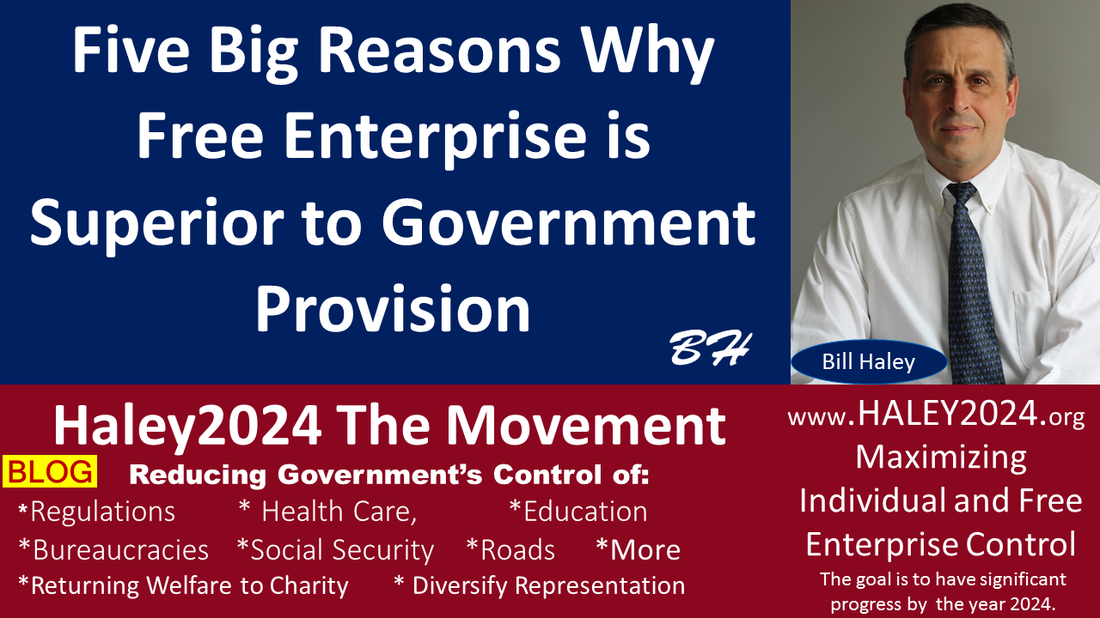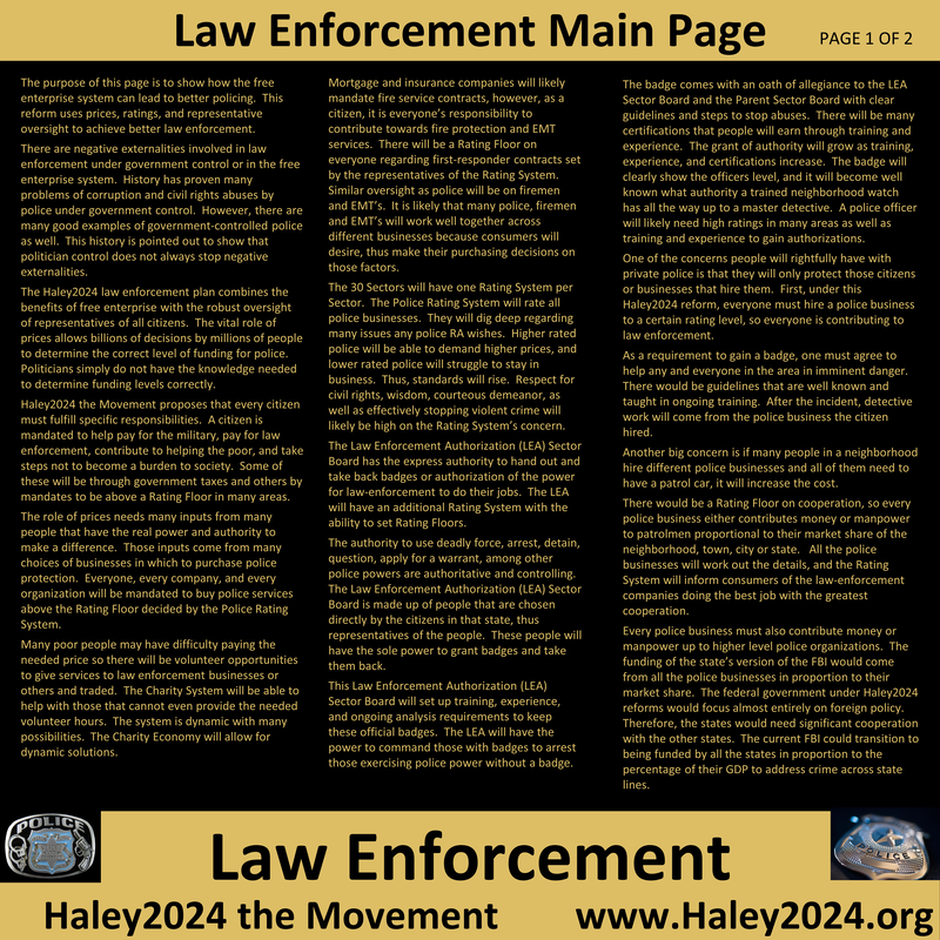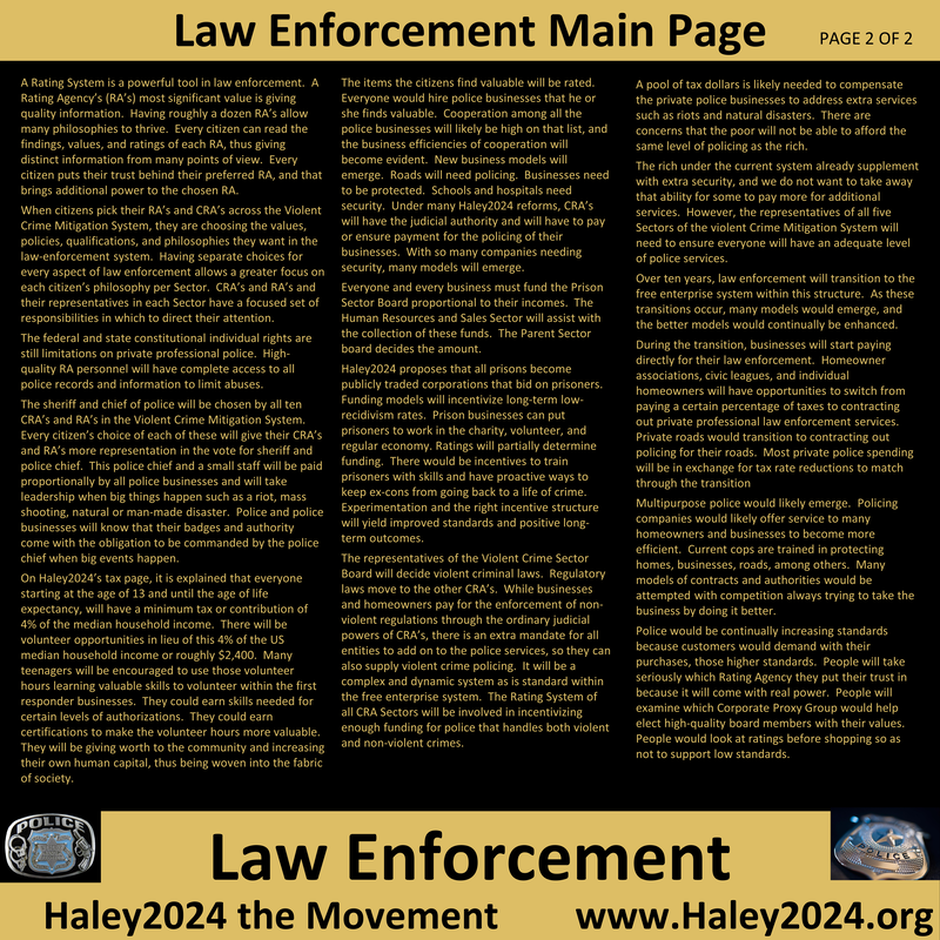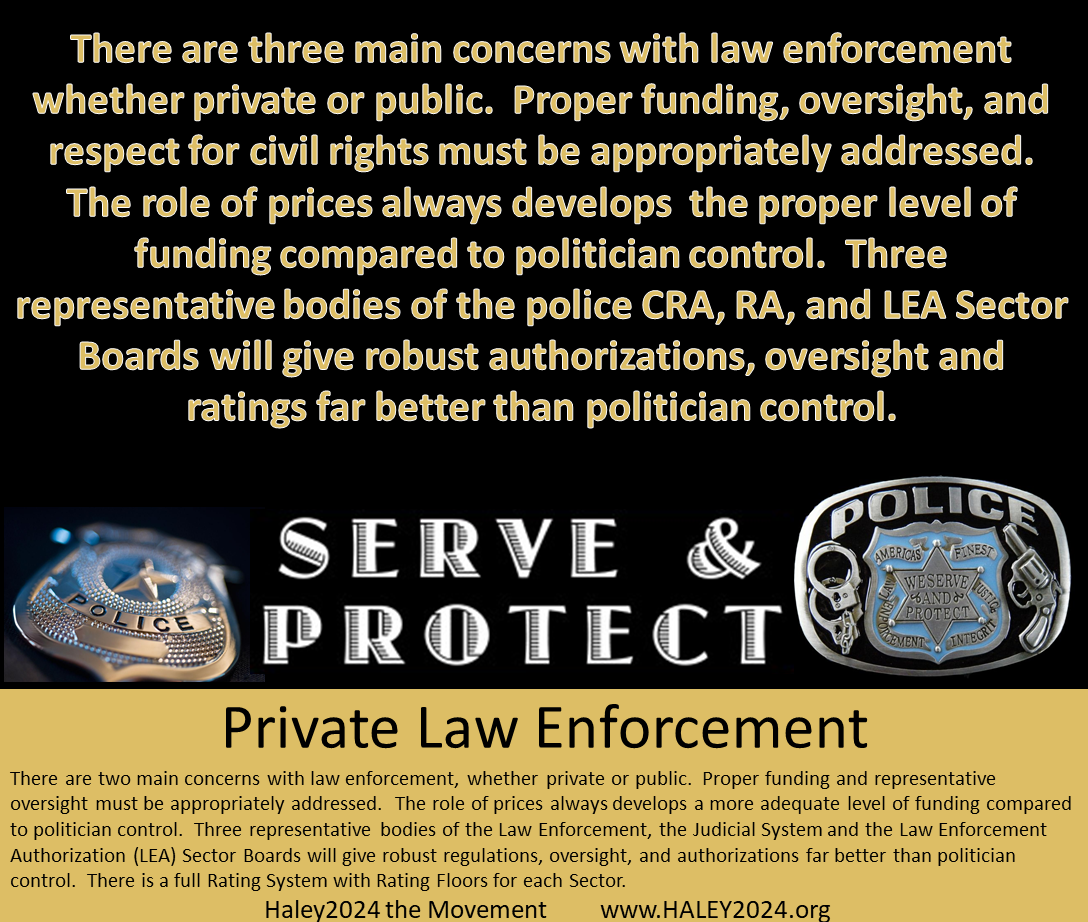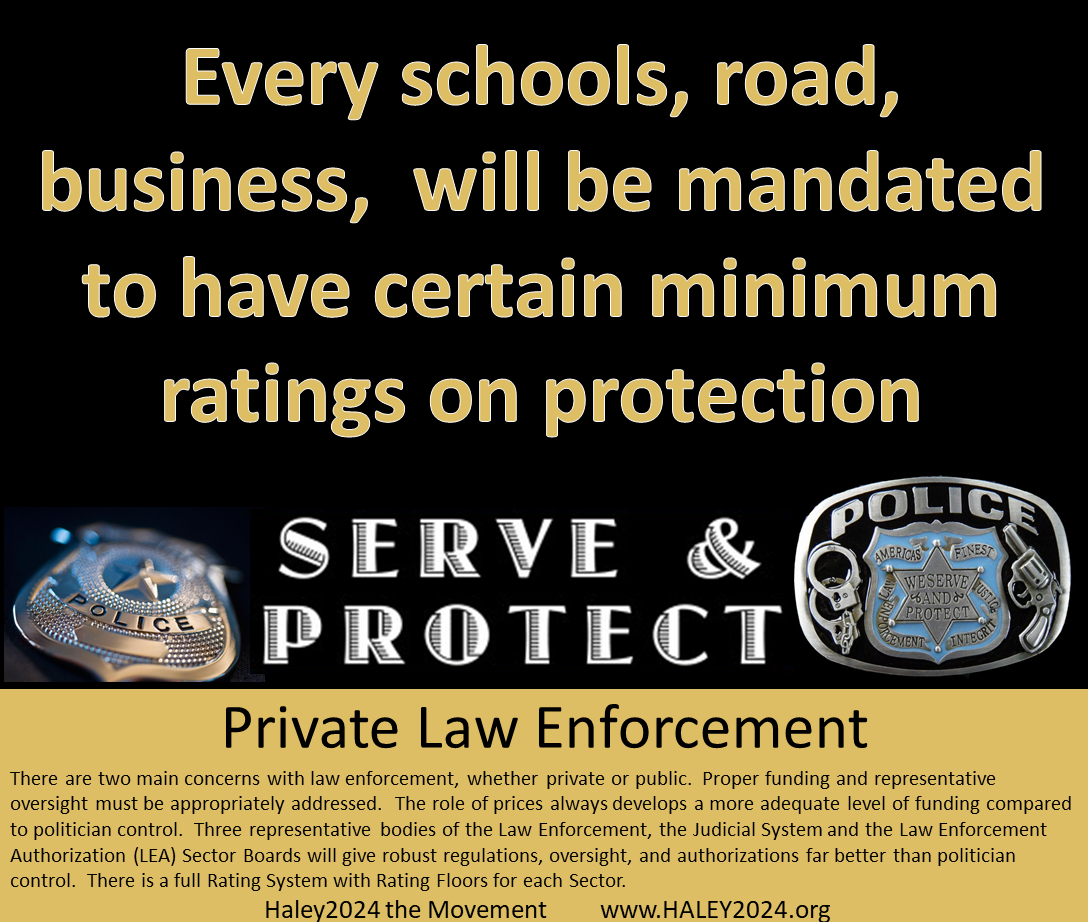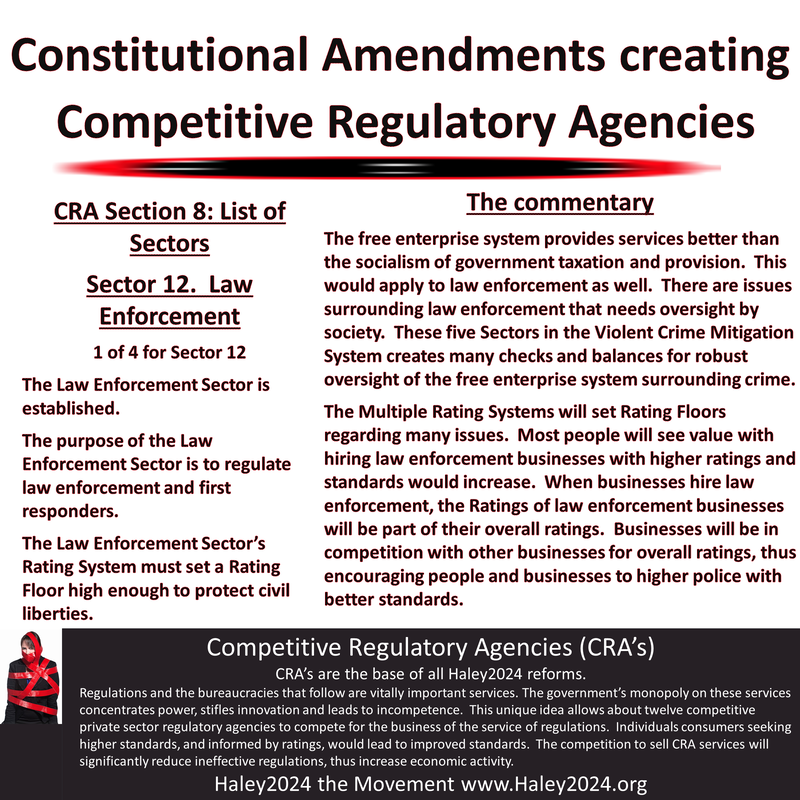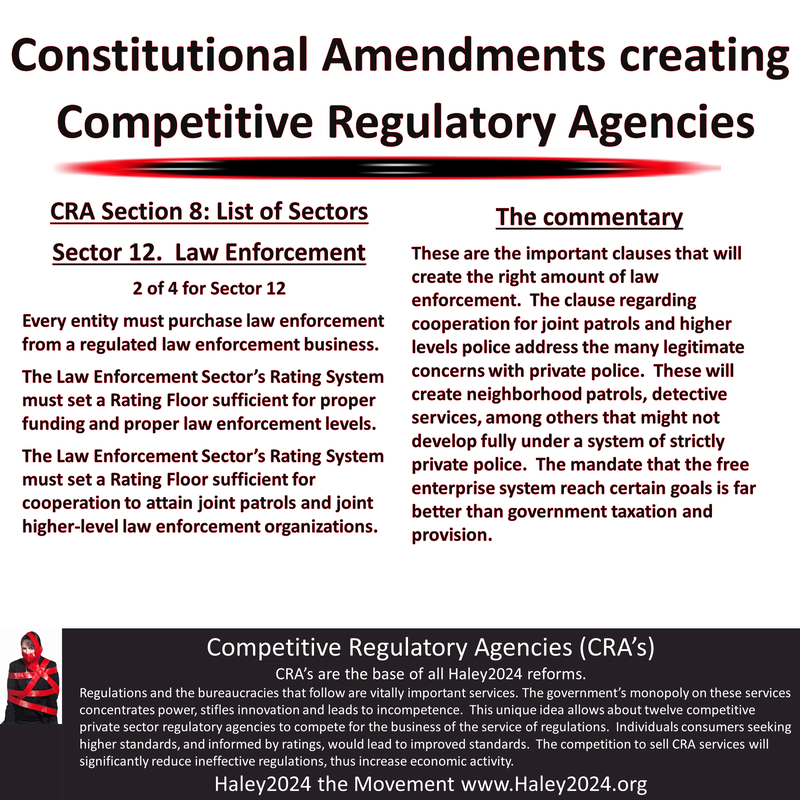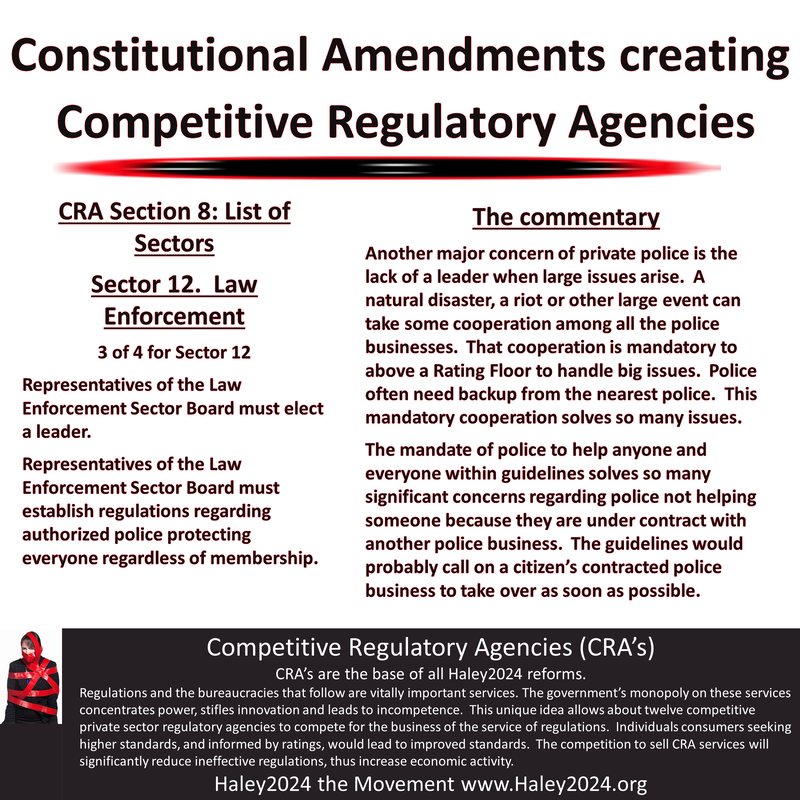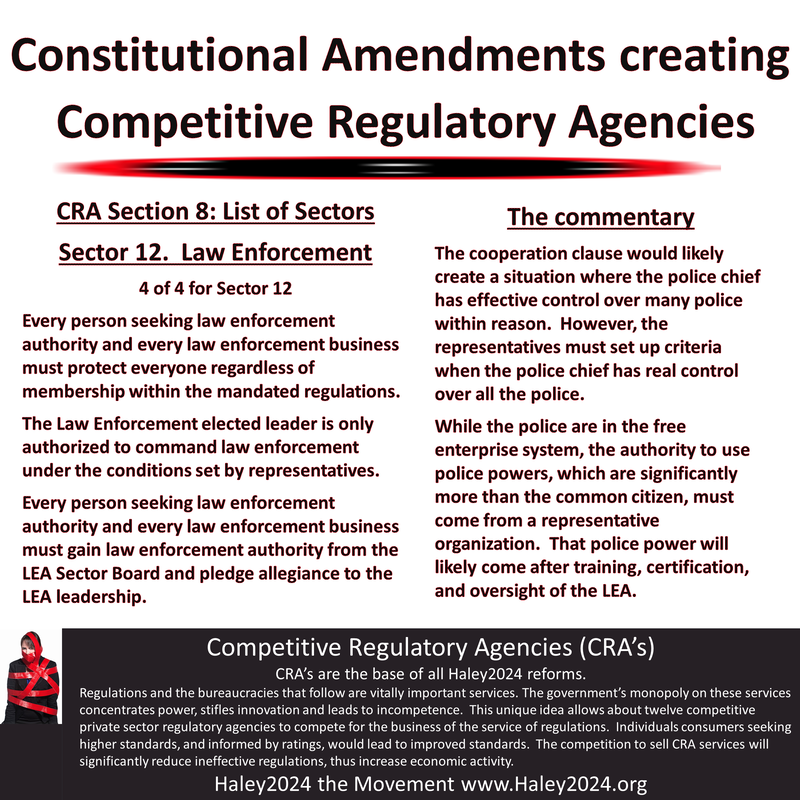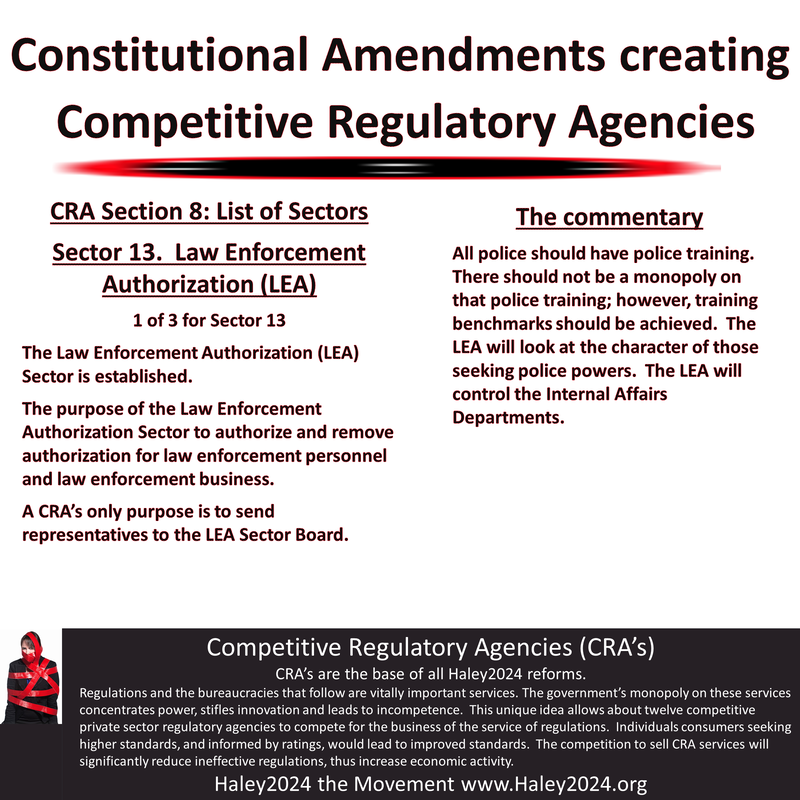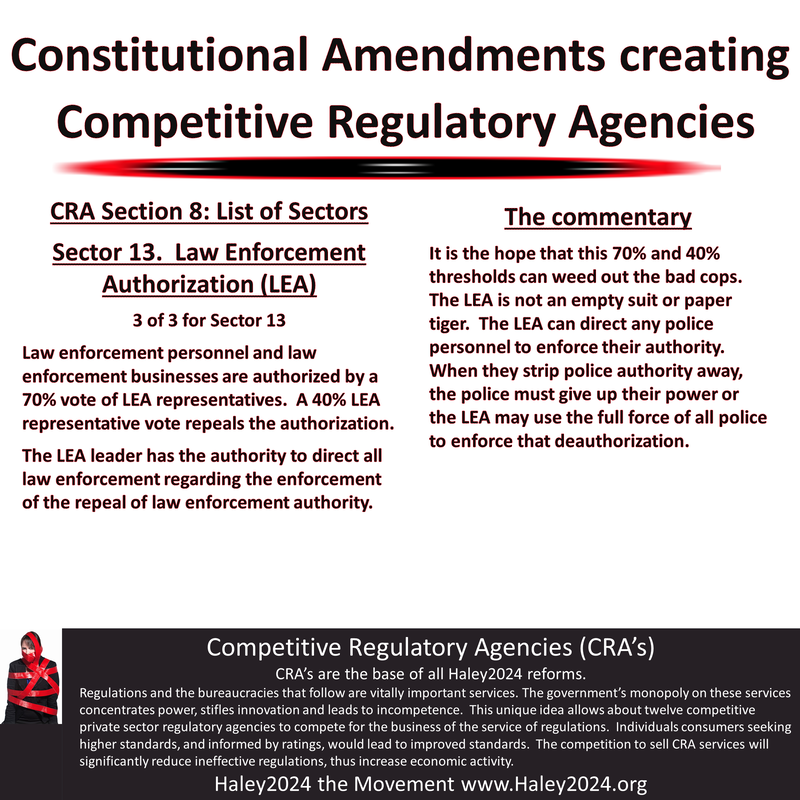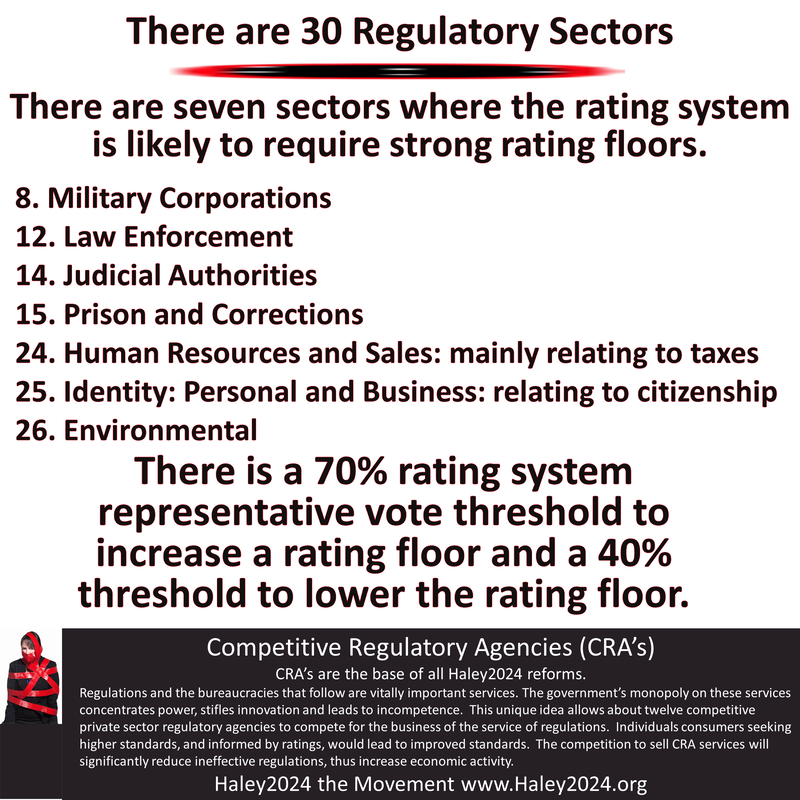Private Law Enforcement
The bullet points above were updated 9-12-2021. For any minor inconsistencies, please use the updated version above. It remains 95% consistent.
|
There are negative externalities involved in law enforcement under government control or in the free enterprise system. History has proven many problems of corruption and civil rights abuses by police under government control. However, there are many good examples of government-controlled police as well. This history is pointed out to show that politician control does not always stop negative externalities.
The Haley2024 law enforcement plan combines the benefits of free enterprise with the robust oversight of representatives of all citizens. The vital role of prices allows billions of decisions by millions of people to determine the correct level of funding for police. Politicians simply do not have the knowledge needed to determine funding levels correctly. |
|
Haley2024 the Movement proposes that every citizen must fulfill specific responsibilities. A citizen is mandated to help pay for the military, pay for law enforcement, contribute to helping the poor, and take steps not to become a burden to society. Some of these will be through government taxes and others by mandates to be above a Rating Floor in many areas.
|
|
The role of prices needs many inputs from many people that have the real power and authority to make a difference. Those inputs come from many choices of businesses in which to purchase police protection. Everyone, every company, and every organization will be mandated to buy police services above the Rating Floor decided by the Police Rating System.
Many poor people may have difficulty paying the needed price so there will be volunteer opportunities to give services to law enforcement businesses or others and traded. The Charity System will be able to help with those that cannot even provide the needed volunteer hours. The system is dynamic with many possibilities. The Charity Economy will allow for dynamic solutions. |
|
Mortgage and insurance companies will likely mandate fire service contracts, however, as a citizen, it is everyone’s responsibility to contribute towards fire protection and EMT services. There will be a Rating Floor on everyone regarding first-responder contracts set by the representatives of the Rating System. Similar oversight as police will be on firemen and EMT’s. It is likely that many police, firemen and EMT’s will work well together across different businesses because consumers will desire, thus make their purchasing decisions on those factors.
|
|
The 30 Sectors will have one Rating System per Sector. The Police Rating System will rate all police businesses. They will dig deep regarding many issues any police RA wishes. Higher rated police will be able to demand higher prices, and lower rated police will struggle to stay in business. Thus, standards will rise. Respect for civil rights, wisdom, courteous demeanor, as well as effectively stopping violent crime will likely be high on the Rating System’s concern.
The Law Enforcement Authorization (LEA) Sector Board has the express authority to hand out and take back badges or authorization of the power for law-enforcement to do their jobs. The LEA will have an additional Rating System with the ability to set Rating Floors. |
|
The authority to use deadly force, arrest, detain, question, apply for a warrant, among other police powers are authoritative and controlling. The Law Enforcement Authorization (LEA) Sector Board is made up of people that are chosen directly by the citizens in that state, thus representatives of the people. These people will have the sole power to grant badges and take them back.
This Law Enforcement Authorization (LEA) Sector Board will set up training, experience, and ongoing analysis requirements to keep these official badges. The LEA will have the power to command those with badges to arrest those exercising police power without a badge. |
|
The badge comes with an oath of allegiance to the LEA Sector Board and the Parent Sector Board with clear guidelines and steps to stop abuses. There will be many certifications that people will earn through training and experience. The grant of authority will grow as training, experience, and certifications increase. The badge will clearly show the officers level, and it will become well known what authority a trained neighborhood watch has all the way up to a master detective. A police officer will likely need high ratings in many areas as well as training and experience to gain authorizations.
|
|
One of the concerns people will rightfully have with private police is that they will only protect those citizens or businesses that hire them. First, under this Haley2024 reform, everyone must hire a police business to a certain rating level, so everyone is contributing to law enforcement.
As a requirement to gain a badge, one must agree to help any and everyone in the area in imminent danger. There would be guidelines that are well known and taught in ongoing training. After the incident, detective work will come from the police business the citizen hired. |
|
Another big concern is if many people in a neighborhood hire different police businesses and all of them need to have a patrol car, it will increase the cost.
There would be a Rating Floor on cooperation, so every police business either contributes money or manpower to patrolmen proportional to their market share of the neighborhood, town, city or state. All the police businesses will work out the details, and the Rating System will inform consumers of the law-enforcement companies doing the best job with the greatest cooperation. |
|
Every police business must also contribute money or manpower up to higher level police organizations. The funding of the state’s version of the FBI would come from all the police businesses in proportion to their market share. The federal government under Haley2024 reforms would focus almost entirely on foreign policy. Therefore, the states would need significant cooperation with the other states. The current FBI could transition to being funded by all the states in proportion to the percentage of their GDP to address crime across state lines.
|
|
A Rating System is a powerful tool in law enforcement. A Rating Agency’s (RA’s) most significant value is giving quality information. Having roughly a dozen RA’s allow many philosophies to thrive. Every citizen can read the findings, values, and ratings of each RA, thus giving distinct information from many points of view. Every citizen puts their trust behind their preferred RA, and that brings additional power to the chosen RA.
|
|
When citizens pick their RA’s and CRA’s across the Violent Crime Mitigation System, they are choosing the values, policies, qualifications, and philosophies they want in the law-enforcement system. Having separate choices for every aspect of law enforcement allows a greater focus on each citizen’s philosophy per Sector. CRA’s and RA’s and their representatives in each Sector have a focused set of responsibilities in which to direct their attention.
The federal and state constitutional individual rights are still limitations on private professional police. High-quality RA personnel will have complete access to all police records and information to limit abuses. |
|
The sheriff and chief of police will be chosen by all ten CRA’s and RA’s in the Violent Crime Mitigation System. Every citizen’s choice of each of these will give their CRA’s and RA’s more representation in the vote for sheriff and police chief. This police chief and a small staff will be paid proportionally by all police businesses and will take leadership when big things happen such as a riot, mass shooting, natural or man-made disaster. Police and police businesses will know that their badges and authority come with the obligation to be commanded by the police chief when big events happen.
|
|
On Haley2024’s tax page, it is explained that everyone starting at the age of 13 and until the age of life expectancy, will have a minimum tax or contribution of 4% of the median household income. There will be volunteer opportunities in lieu of this 4% of the US median household income or roughly $2,400. Many teenagers will be encouraged to use those volunteer hours learning valuable skills to volunteer within the first responder businesses. They could earn skills needed for certain levels of authorizations. They could earn certifications to make the volunteer hours more valuable. They will be giving worth to the community and increasing their own human capital, thus being woven into the fabric of society.
|
|
The items the citizens find valuable will be rated. Everyone would hire police businesses that he or she finds valuable. Cooperation among all the police businesses will likely be high on that list, and the business efficiencies of cooperation will become evident. New business models will emerge. Roads will need policing. Businesses need to be protected. Schools and hospitals need security. Under many Haley2024 reforms, CRA’s will have the judicial authority and will have to pay or ensure payment for the policing of their businesses. With so many companies needing security, many models will emerge.
|
|
Everyone and every business must fund the Prison Sector Board proportional to their incomes. The Human Resources and Sales Sector will assist with the collection of these funds. The Parent Sector board decides the amount.
Haley2024 proposes that all prisons become publicly traded corporations that bid on prisoners. Funding models will incentivize long-term low-recidivism rates. Prison businesses can put prisoners to work in the charity, volunteer, and regular economy. Ratings will partially determine funding. There would be incentives to train prisoners with skills and have proactive ways to keep ex-cons from going back to a life of crime. Experimentation and the right incentive structure will yield improved standards and positive long-term outcomes. |
|
The representatives of the Violent Crime Sector Board will decide violent criminal laws. Regulatory laws move to the other CRA’s. While businesses and homeowners pay for the enforcement of non-violent regulations through the ordinary judicial powers of CRA’s, there is an extra mandate for all entities to add on to the police services, so they can also supply violent crime policing. It will be a complex and dynamic system as is standard within the free enterprise system. The Rating System of all CRA Sectors will be involved in incentivizing enough funding for police that handles both violent and non-violent crimes.
|
|
The rich under the current system already supplement with extra security, and we do not want to take away that ability for some to pay more for additional services. However, the representatives of all five sectors of the violent Crime Mitigation System will need to ensure everyone will have an adequate level of police services.
|
|
During the transition, businesses will start paying directly for their law enforcement. Homeowner associations, civic leagues, and individual homeowners will have opportunities to switch from paying a certain percentage of taxes to contracting out private professional law enforcement services. Private roads would transition to contracting out policing for their roads. Most private police spending will be in exchange for tax rate reductions to match through the transition.
|
|
Multipurpose police would likely emerge. Policing companies would likely offer service to many homeowners and businesses to become more efficient. Current cops are trained in protecting homes, businesses, roads, among others. Many models of contracts and authorities would be attempted with competition always trying to take the business by doing it better.
|
|
Police would be continually increasing standards because customers would demand with their purchases, those higher standards. People will take seriously which Rating Agency they put their trust in because it will come with real power. People will examine which Corporate Proxy Group would help elect high-quality board members with their values. People would look at ratings before shopping so as not to support low standards.
|





